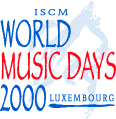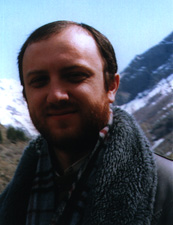 |
SEPTEMBER 29TH - OCTOBER 8TH 2000 |
|
organised by  (ISCM Luxembourg Section) Information: info@worldmusicdays.com |
Yassen Vodenitcharov

Yassen Vodenitcharov was born in Bulgaria in 1964. From 1985 to 1990, he studied
composition in the class of Dimitar Tapkov and piano in the class of Lilana Antova at the
National Conservatory in Sofia. He attended a course in electroacoustic music at Radio
France in 1991 and was then admitted to the Paris Conservatory in the composition class of
Paul Méfano, receiving his diploma in 1995. In 1993, he was awarded a special prize in the
Tenth Composition Competition Gen-On in Tokyo. His works have been played at numerous
concerts and festivals and have been frequently broadcast. Yassen Vodenitcharov receives
regular commissions from the French State and Ministry of Culture, from Radio France and
from ensembles such as 2E2M and Itinéraire.
Shaman's songs
The flute is one of the most ancient and wide-spread instruments in the world, starting with
Africa and continuing via Europe and Asia to the most remote parts of South America. We
rarely find any traditional cultures which do not know, or make use of the flute. This gives the
instrument a universal aspect.
In the present age, when composers are constantly querying the inherited formulae of the
classical era, they often use special combinations of instruments, sometimes turning to older
sources and cultures. Thus, in my piece, the use of a flute orchestra encompassing all
registers, combined with percussion instruments, is somewhat unusual in terms of classic
instrumentation, but the practice is quite common in certain traditional cultures as evidenced
by the famous flute orchestras of South America.
This piece for solo flute, alternating with tenor flute, bass flute, flute in C and piccolo could
be considered as a concerto but it is more ritual in character. It is written in four parts in
which the incantation, litanies and frenzied cries of the individual or chief, represented by the
soloist, alternate with interventions by the crowd, represented by the orchestra. Each member
of the orchestra has a different part, but the parts together reflect the crowd and no part has
an individual character; the way in which each merges into the crowd gives a powerful
movement to the ensemble. The use of simple rhythms and pulses, alternating with a total
absence of pulse and "chaotic" passages, accents the archaic and primitive aspect which I
tried to achieve in the score, this being a kind of tribute to Igor Stravinsky.